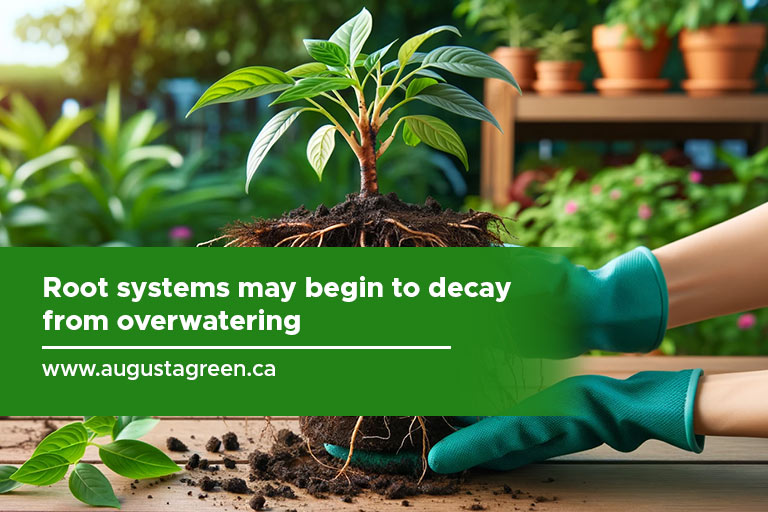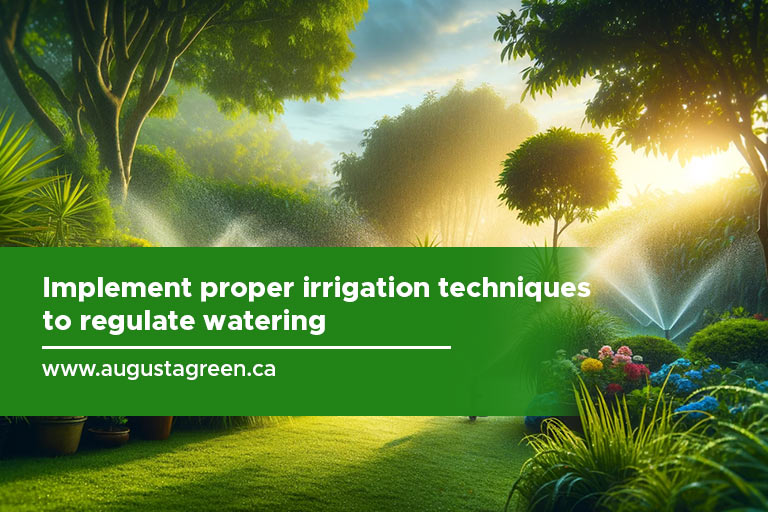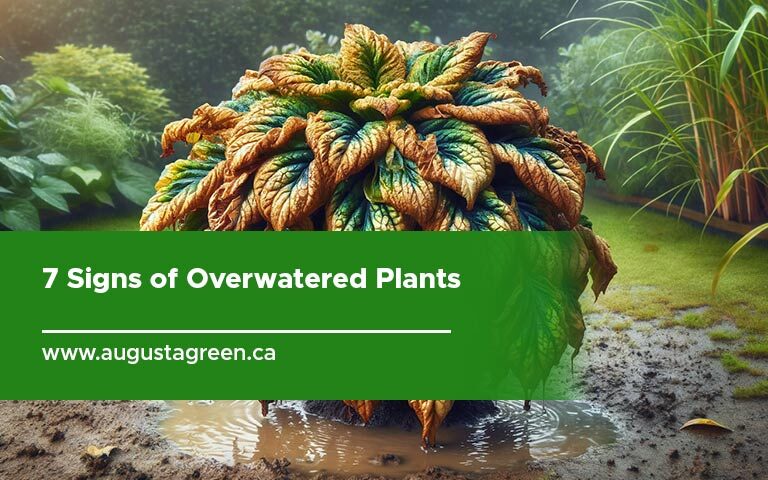Water is a fundamental element for plant growth, aiding in photosynthesis and nutrient absorption. However, there is a fine line between adequate hydration and overwatering. When plants are overwatered, the excess moisture suffocates the roots, preventing them from absorbing necessary nutrients and oxygen. This can lead to various health issues, making it essential to recognize the early signs of overwatering.
Recognizing these signs is not just about maintaining the aesthetic appeal of your plants but also about ensuring their health and longevity. Here are some tips on how to tell if plants are overwatered:
1. Persistent Wet Soil
Healthy soil strikes a balance between moisture and aeration, supporting robust root growth and nutrient absorption. Soil that remains persistently wet creates an anaerobic environment, detrimental to plant health. This constant wetness hinders roots from accessing vital air pockets, leading to suffocation. Over time, such conditions foster the development of root diseases, as the roots begin to decay in the absence of oxygen. The lack of a dry cycle in the soil also disrupts the natural growth and rest phases of the plant’s roots, leading to further stress and potential damage.
2. Discoloured Leaves
The discolouration of leaves in overwatered plants is a distress signal, indicating an imbalance in the plant’s internal processes. Typically manifesting as yellowing or browning, particularly at the tips or edges, this change in leaf colour is a result of nutrient deficiencies. Excessive water in the soil limits the roots’ ability to absorb essential nutrients. The compromised root system fails to transport necessary minerals and water to the leaves, causing them to lose their vibrant green hue and eventually deteriorate.
3. Wilted Leaves
Wilted leaves in overwatered plants present a paradoxical symptom, as one might associate wilting with a lack of water. However, in this case, the drooping is caused by an oversaturation of the soil, leading to waterlogged roots. These saturated conditions impede the roots’ ability to function properly, restricting their absorption and transportation of water and nutrients. The resulting stress causes the leaves to droop and wilt, reflecting the plant’s struggle to maintain its normal physiological processes in an overly moist environment.
4. Root Rot

Root rot is another sign of too much water in plants, often marking a point of no return for plant health. It occurs when excessive moisture in the soil encourages the proliferation of fungi, which attack and decay the plant’s roots. This decay not only impairs the plant’s ability to absorb nutrients and water but also emits a foul odour, a telltale sign of the rotting process. The roots turn black or brown and become mushy, indicating extensive damage and a significant threat to the plant’s survival.
5. Soft and Squishy Stem
Overwatering affects not only the roots and leaves but also the stems of plants. When exposed to excessive moisture for prolonged periods, plant stems become soft and squishy, losing their structural integrity. This softening is a result of the breakdown of the plant’s internal cell structures within the stem, a process that can lead to the collapse and decay of the plant. These softened stems are less capable of supporting the plant and are more susceptible to diseases and physical damage, further exacerbating the plant’s decline.
6. Stunted Growth
A noticeable slowdown or halt in growth is one of the effects of overwatering on plant health. The oversaturated soil conditions impair root function, preventing them from effectively absorbing essential nutrients and water. This nutrient deprivation hampers the plant’s development, leading to stunted growth. The roots, struggling to cope with the excess water, cannot support the plant’s normal growth patterns, resulting in smaller leaves, shorter stems, and a general lack of vigour.
7. Pests Around Your Plant
Excess moisture in the soil creates a hospitable environment for various pests, such as fungus gnats, which thrive in damp conditions. These pests are attracted to the wet soil and decaying organic matter, often exacerbated by overwatering. The presence of these pests is not only a nuisance but can also lead to further stress on the plant as they may feed on or damage the roots and leaves. The increase in pest activity around an overwatered plant serves as an indicator of the unhealthy moisture levels in the soil.
Preventing Overwatering in Garden Plants

- Understand Your Plant’s Water Needs
Different plants have varying water requirements. To properly identify overwatered indoor plants, begin by researching and understanding the specific needs of each plant in your garden or home. Some plants thrive in moist soil, while others prefer drier conditions. Knowing the ideal watering frequency and volume for each plant type helps in providing just the right amount of water.
- Check Soil Moisture Before Watering
Don’t rely solely on a watering schedule. Instead, check the soil moisture before adding water. You can do this by simply touching the soil, using a moisture meter, or inserting a finger or a stick into the soil. If the top inch of the soil (about 2.5 cm) is dry, it’s usually a good time to water. If the soil feels damp, hold off on watering.
- Use Well-Draining Soil and Pots with Drainage Holes
Proper drainage is key to preventing overwatering. Ensure your plants are in pots with drainage holes to allow excess water to escape. Additionally, using well-draining soil mixtures helps prevent water from pooling around the roots. For potted plants, a mixture of potting soil with materials like perlite, vermiculite, or sand can enhance drainage.
- Be Mindful of Environmental Conditions
Environmental factors like temperature, humidity, and light levels can significantly impact how much water your plants need. Plants typically require less water in cooler or less sunny conditions and more in warmer or brighter environments. Also, indoor plants often need less frequent watering compared to those outdoors. Adjust your watering habits to reflect these varying conditions.
- Implement Proper Watering Techniques
How you water is just as important as how often. Water slowly and deeply, allowing the moisture to reach the roots rather than just wetting the surface. Avoid overhead watering that wets the foliage and can lead to fungal diseases. For outdoor plants, consider using drip irrigation or soaker hoses that deliver water directly to the soil and roots, minimizing waste and evaporation.
Recognizing the signs of overwatering is crucial for the health of your plants. By paying attention to the condition of the soil, leaves, stems, roots, and overall plant growth, you can ensure that your plants are receiving the right amount of water. Adjusting your watering schedule and ensuring proper drainage can help prevent overwatering and promote healthy plant growth.
A little awareness and adjustment in your gardening routine can make a substantial difference. If you are unsure about the right amount of water for your plants or if you’re dealing with persistent overwatering issues, consider professional help. Consider lawn sprinklers in Toronto from Augusta Green Sprinklers or call 416-227-1666 for expert advice on efficient and balanced watering solutions.

